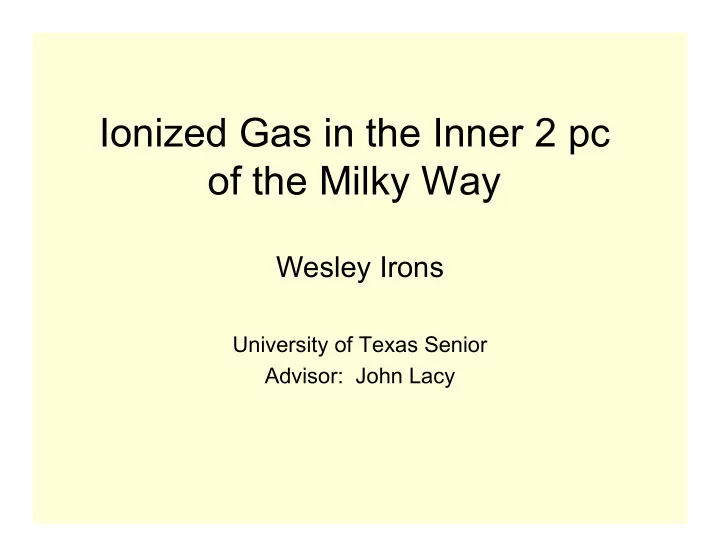

Ionized Gas in the Inner 2 pc of the Milky Way Wesley Irons University of Texas Senior Advisor: John Lacy
The Galactic Center • Sgr A* (x) • Circumnuclear Disk • Mini-spiral – Northern Arm (--) – Western Arc (--) – Eastern Arm (--) – Bar (--)
The Goal • Use better data – Observations of [NeII] emission from the Galactic Center using TEXES, a high-resolution mid-infrared spectrograph, on the NASA IRTF in July, 2003. • Analyze two interpretations for the gas kinematics 1) Tidally stretched clouds with gas flowing along the streamers ( Serabyn et al., Zhao et al.) 2) One-armed spiral structure with gas flowing across the filaments on circular orbits ( Lacy et al.) Determine the better spectral fit and speculate • on the physics behind that interpretation
One Interpretation • Tidally stretched clouds • Motion along the streamers - falling in toward Sgr A* • Northern Arm, Western Arc, and Eastern Arm modeled as separate ellipses with Sgr A* at the focus (Zhao et al. 2009)
Position-Velocity diagram of the northern arm ellipse Position in degrees along ellipse Doppler velocity in Km/s And the western arc ellipse Position in degrees along ellipse Doppler velocity in Km/s
Position-velocity diagram for the Eastern Arm Ellipse Position in degrees along ellipse Doppler velocity in Km/s *This is the least convincing fit, but at the moment, the eastern arm is not addressed in the spiral model
Try Circular Motion • Shift datacube spectrally to collect all emission that fits circular velocities in a plane specified by a set of parameters. • The summed spectra after shifting can be compared • A shows the spectrum before shifting, B shows the best fit A B i = 63 ° pa = 18 ° M BH = 4.2e6M sun M * (r) = (1e6 × r 1.2 ) M sun
The Spiral
[NeII] emission map Only emission fitting summed over all spectral circular velocities within points 30km/s with spiral drawn
Position-velocity diagram for spiral Purely circular motion Small inward velocity Position in degrees along Spiral Position in degrees along Spiral Doppler velocity in Km/s Doppler velocity in Km/s
A Physical Explanation? • Spiraling inward - doesn’t fit data Collapsed spectrum for motion • Density wave - not enough mass in along the spiral gas to self gravitate, contrast too big (10:1) • Magnetorotational Instability (MRI) - common in accretion disks, magnetic forces not large enough for such an open spiral - would very gradually spiral in • Spiral ionization wave - lots of massive stars in dark regions, why is the whole disk not ionized? • Tidally stretched cloud - doesn’t fit data well - must it stretch along motion? No argument is completely airtight
Conclusion • The data supports the one-armed spiral model - The northern arm and the western arc appear to be one structure in a single plane • More theoretical work is needed References: Zhao et al. (2009), Dynamics of Ionized Gas at the Galactic Center, ApJ (2009) vol. 699 pp. 186 Lacy et al. (1991), Galactic center gasdynamics - A one-armed spiral in a Keplerian disk. ApJL (1991) vol. 380 pp. L71 Montero-Castano et al. (2009), Gas Infall Toward Sgr A* from the Clumpy Circumnuclear Disk. ApJ (2009) vol. 695 pp. 1477
Recommend
More recommend